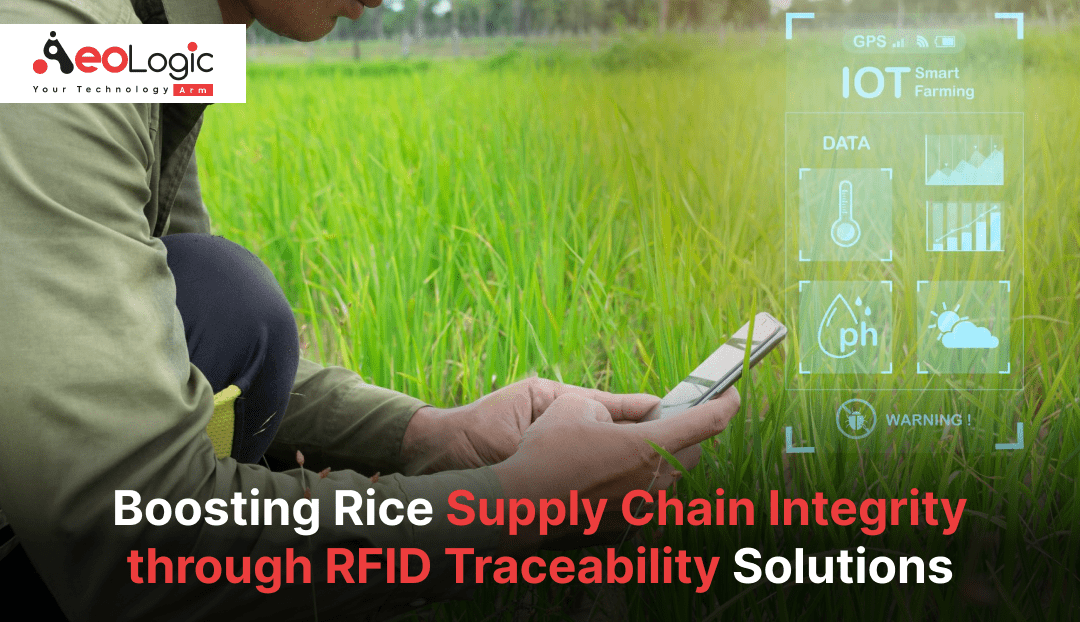In today’s global market, the integrity of the food supply chain is more critical than ever. With a growing emphasis on food safety, quality, and sustainability, industries are exploring innovative solutions to address challenges in traceability and transparency.
One such advancement is the integration of Radio Frequency Identification (RFID) technology into the rice supply chain. This blog delves into how RFID traceability solutions are transforming rice supply chain integrity, offering benefits from farm to table.
Also read: Impact of RFID Solutions in the Pharmaceutical Industry
The RFID Traceability Solutions: Complexity and Challenges
The rice supply chain is a complex network involving various stages: cultivation, harvesting, processing, packaging, distribution, and consumption. Each stage involves multiple stakeholders, including farmers, millers, distributors, retailers, and consumers. Given this complexity, maintaining a transparent and efficient supply chain can be challenging. Issues such as counterfeit products, contamination, and inefficiencies can impact the quality and safety of rice, affecting consumer trust and industry reputation.
The Role of RFID Technology
RFID technology utilizes radio waves to transmit data between a reader and an RFID tag attached to an item. This tag can store information such as production details, batch numbers, and expiration dates. The data captured can be accessed in real-time, providing an accurate and comprehensive view of the product’s journey through the supply chain. Here’s how RFID traceability solutions are making a difference in the rice industry:
Enhanced Transparency
One of the most significant benefits of RFID technology is the increased transparency it offers. Each RFID tag provides a unique identifier for the rice, which is linked to a digital record containing detailed information about the product. This information can include the origin of the rice, processing methods, and quality control measures. By scanning the RFID tag at various points along the supply chain, stakeholders can access this data, ensuring that the rice meets safety and quality standards.
Improved Traceability
In the event of a food safety issue, quick and accurate traceability is crucial. RFID traceability solutions enables precise tracking of rice from its origin to its final destination. If contamination or a recall is necessary, RFID systems can pinpoint the affected batches, reducing the scope of the recall and minimizing potential harm. This rapid response capability helps protect consumers and supports regulatory compliance.
Efficient Inventory Management
Managing inventory efficiently is vital in the rice industry, where demand can fluctuate seasonally. RFID asset tracking technology facilitates real-time inventory tracking, allowing producers and distributors to monitor stock levels, manage supply chain flows, and reduce waste. With accurate inventory data, stakeholders can make informed decisions about production and distribution, optimizing resource use and minimizing costs.
Fraud Prevention
Counterfeit rice and fraudulent practices can undermine consumer trust and harm the reputation of legitimate producers. RFID tags provide a secure and tamper-evident way to verify the authenticity of rice products. By linking each batch of rice to a unique digital record, RFID technology helps prevent counterfeiting and ensures that consumers receive genuine products.
Streamlined Logistics
RFID technology simplifies logistics by automating data capture and reducing manual processes. RFID readers can quickly scan multiple items at once, speeding up processes such as loading, unloading, and sorting. This automation not only enhances efficiency but also reduces human error, leading to more accurate and reliable operations.
Implementing RFID in the Rice Supply Chain
Integrating RFID technology into the rice supply chain requires a strategic approach. Here are key steps to consider for successful implementation:
Assessing Needs and Objectives
Before adopting RFID traceability solutions, it’s essential to assess the specific needs and objectives of the supply chain. Determine which aspects of the supply chain would benefit most from RFID traceability, such as inventory management, quality control, or fraud prevention. This assessment will guide the selection of appropriate RFID technologies and solutions.
Choosing the Right RFID System
There are various RFID technologies available, including passive and active tags. Passive tags are cost-effective and suitable for many applications, while active tags offer extended range and additional features. Selecting the right RFID system depends on factors such as the size of the supply chain, environmental conditions, and budget constraints.
Integrating with Existing Systems
RFID technology should seamlessly integrate with existing supply chain management systems. This integration ensures that data from RFID tags can be easily incorporated into current databases and software platforms. Collaboration with technology providers and IT professionals can facilitate smooth integration and data synchronization.
Training and Education
Successful implementation of RFID solutions requires training for all stakeholders involved in the supply chain. Educate farmers, processors, distributors, and retailers on how to use RFID technology effectively. Training ensures that everyone understands the benefits of RFID traceability solutions and can contribute to its successful adoption.
Monitoring and Optimization
After implementing RFID solutions, continuously monitor their performance and impact on the supply chain. Collect feedback from users and analyze data to identify areas for improvement. Regularly review and optimize RFID systems to address any challenges and maximize their benefits.
Also read: Benefits of RFID Solutions in Hospital and Clinical Pharmacy
Conclusion
RFID traceability solutions represent a significant advancement in enhancing the integrity of the rice supply chain. By providing improved transparency, traceability, and efficiency, RFID technology helps address key challenges and supports the delivery of high-quality, safe rice products to consumers. As the rice industry continues to evolve, embracing innovative solutions like RFID will be crucial in maintaining trust, ensuring food safety, and driving sustainable practices. The future of rice supply chain management lies in leveraging technology to create a more transparent, efficient, and reliable system from farm to table.







